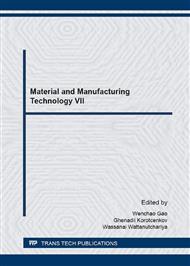p.123
p.128
p.133
p.138
p.147
p.152
p.157
p.162
p.168
Effect of Anodizing Voltage on Anodic Titanium Dioxide (ATO) Growth Based on an Ethylene Glycol Solution Containing NH4F
Abstract:
We reported on the influence of applied voltage on the surface morphology of anodic titanium dioxide (ATO) thin films. At first, titanium (Ti) thin films were prepared by DC-magnetron sputtering for use as a base material in the anodization process. The titanium dioxide (TiO2) nanoporous ATO was fabricated by the anodization process from the Ti thin film, with different applied voltages from 20 V to 60 V in an electrolyte based on an ethylene glycol containing NH4F. Pore size distribution of ATO thin films can be varied from 20-50 nm by increasing the applied voltage, while the thickness of the film also increases. In addition, to observe the effect of time, the optimal condition of anodizing voltage was studied by increasing the anodizing time. The results clearly showed the nanoporous ATO over the films and the thickness of the nanoporous ATO is approximately 260 nm.
Info:
Periodical:
Pages:
147-151
Citation:
Online since:
September 2016
Keywords:
Price:
Сopyright:
© 2016 Trans Tech Publications Ltd. All Rights Reserved
Share:
Citation:


